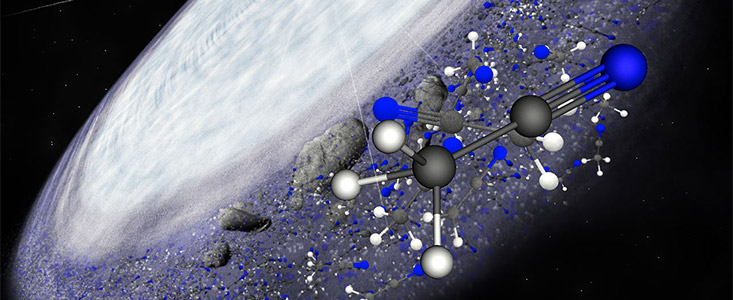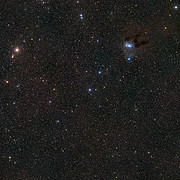Press Release
Complex Organic Molecules Discovered in Infant Star System
Hints that the building blocks of the chemistry of life are universal
8 April 2015
For the first time, astronomers have detected the presence of complex organic molecules, the building blocks of life, in a protoplanetary disc surrounding a young star. The discovery, made with the Atacama Large Millimeter/submillimeter Array (ALMA), reaffirms that the conditions that spawned the Earth and Sun are not unique in the Universe. The results are published in the 9 April 2015 issue of the journal Nature.
The new ALMA observations reveal that the protoplanetary disc surrounding the young star MWC 480 [1] contains large amounts of methyl cyanide (CH3CN), a complex carbon-based molecule. There is enough methyl cyanide around MWC 480 to fill all of Earth’s oceans.
Both this molecule and its simpler cousin hydrogen cyanide (HCN) were found in the cold outer reaches of the star’s newly formed disc, in a region that astronomers believe is analogous to the Kuiper Belt — the realm of icy planetesimals and comets in our own Solar System beyond Neptune.
Comets retain a pristine record of the early chemistry of the Solar System, from the period of planet formation. Comets and asteroids from the outer Solar System are thought to have seeded the young Earth with water and organic molecules, helping set the stage for the development of primordial life.
“Studies of comets and asteroids show that the solar nebula that spawned the Sun and planets was rich in water and complex organic compounds,” noted Karin Öberg, an astronomer with the Harvard-Smithsonian Center for Astrophysics in Cambridge, Massachusetts, USA, and lead author of the new paper.
“We now have even better evidence that this same chemistry exists elsewhere in the Universe, in regions that could form solar systems not unlike our own.” This is particularly intriguing, Öberg notes, since the molecules found in MWC 480 are also found in similar concentrations in the Solar System’s comets.
The star MWC 480, which is about twice the mass of the Sun, is located 455 light-years away in the Taurus star-forming region. Its surrounding disc is in the very early stages of development — having recently coalesced out of a cold, dark nebula of dust and gas. Studies with ALMA and other telescopes have yet to detect any obvious signs of planet formation in it, although higher resolution observations may reveal structures similar to HL Tauri, which is of a similar age.
Astronomers have known for some time that cold, dark interstellar clouds are very efficient factories for complex organic molecules — including a group of molecules known as cyanides. Cyanides, and most especially methyl cyanide, are important because they contain carbon–nitrogen bonds, which are essential for the formation of amino acids, the foundation of proteins and the building blocks of life.
Until now, it has remained unclear, however, if these same complex organic molecules commonly form and survive in the energetic environment of a newly forming solar system, where shocks and radiation can easily break chemical bonds.
By exploiting ALMA’s remarkable sensitivity [2] astronomers can see from the latest observations that these molecules not only survive, but flourish.
Importantly, the molecules ALMA detected are much more abundant than would be found in interstellar clouds. This tells astronomers that protoplanetary discs are very efficient at forming complex organic molecules and that they are able to form them on relatively short timescales [3].
As this system continues to evolve, astronomers speculate that it’s likely that the organic molecules safely locked away in comets and other icy bodies will be ferried to environments more nurturing to life.
“From the study of exoplanets, we know the Solar System isn’t unique in its number of planets or abundance of water,” concluded Öberg. “Now we know we’re not unique in organic chemistry. Once more, we have learnt that we’re not special. From a life in the Universe point of view, this is great news.”
Notes
[1] This star is only about one million years old. By comparison the Sun is more than four billion years old. The name MWC 480 refers to the Mount Wilson Catalog of B and A stars with bright hydrogen lines in their spectra.
[2] ALMA is able to detect the faint millimetre-wavelength radiation that is naturally emitted by molecules in space. For these most recent observations, the astronomers used only a portion of ALMA’s 66 antennas when the telescope was in its lower-resolution configuration. Further studies of this and other protoplanetary discs with ALMA’s full capabilities will reveal additional details about the chemical and structural evolution of stars and planets.
[3] This rapid formation is essential to outpace the forces that would otherwise break the molecules apart. Also, these molecules were detected in a relatively serene part of the disc, roughly 4.5 to 15 billion kilometres from the central star. Though very distant by Solar System standards, in MWC 480’s scaled-up dimensions, this would be squarely in the comet-forming zone.
More information
This research was presented in a paper entitled “The Cometary Composition of a Protoplanetary Disk as Revealed by Complex Cyanides” by K.I. Öberg et al., to appear in the journal Nature on 9 April 2015.
The team is composed of Karin I. Öberg (Harvard-Smithsonian Centre for Astrophysics, Cambridge, Massachusetts, USA), Viviana V. Guzmán (Harvard-Smithsonian Centre for Astrophysics), Kenji Furuya (Leiden Observatory, Leiden University, Leiden, the Netherlands), Chunhua Qi (Harvard-Smithsonian Centre for Astrophysics), Yuri Aikawa (Kobe University, Kobe, Japan), Sean M. Andrews (Harvard-Smithsonian Centre for Astrophysics), Ryan Loomis (Harvard-Smithsonian Centre for Astrophysics) and David J. Wilner (Harvard-Smithsonian Centre for Astrophysics).
The Atacama Large Millimeter/submillimeter Array (ALMA), an international astronomy facility, is a partnership of ESO, the US National Science Foundation (NSF) and the National Institutes of Natural Sciences (NINS) of Japan in cooperation with the Republic of Chile. ALMA is funded by ESO on behalf of its Member States, by NSF in cooperation with the National Research Council of Canada (NRC) and the National Science Council of Taiwan (NSC) and by NINS in cooperation with the Academia Sinica (AS) in Taiwan and the Korea Astronomy and Space Science Institute (KASI).
ALMA construction and operations are led by ESO on behalf of its Member States; by the National Radio Astronomy Observatory (NRAO), managed by Associated Universities, Inc. (AUI), on behalf of North America; and by the National Astronomical Observatory of Japan (NAOJ) on behalf of East Asia. The Joint ALMA Observatory (JAO) provides the unified leadership and management of the construction, commissioning and operation of ALMA.
ESO is the foremost intergovernmental astronomy organisation in Europe and the world’s most productive ground-based astronomical observatory by far. It is supported by 16 countries: Austria, Belgium, Brazil, Czechia, Denmark, France, Finland, Germany, Italy, the Netherlands, Poland, Portugal, Spain, Sweden, Switzerland and the United Kingdom, along with the host state of Chile. ESO carries out an ambitious programme focused on the design, construction and operation of powerful ground-based observing facilities enabling astronomers to make important scientific discoveries. ESO also plays a leading role in promoting and organising cooperation in astronomical research. ESO operates three unique world-class observing sites in Chile: La Silla, Paranal and Chajnantor. At Paranal, ESO operates the Very Large Telescope, the world’s most advanced visible-light astronomical observatory and two survey telescopes. VISTA works in the infrared and is the world’s largest survey telescope and the VLT Survey Telescope is the largest telescope designed to exclusively survey the skies in visible light. ESO is a major partner in ALMA, the largest astronomical project in existence. And on Cerro Armazones, close to Paranal, ESO is building the 39-metre European Extremely Large Telescope, the E-ELT, which will become “the world’s biggest eye on the sky”.
Links
Contacts
Karin Öberg
Harvard-Smithsonian Centre for Astrophysics
Cambridge MA, USA
Cell: +1 617 496 9062
Email: koberg@cfa.harvard.edu
Richard Hook
ESO, Public Information Officer
Garching bei München, Germany
Tel: +49 89 3200 6655
Cell: +49 151 1537 3591
Email: rhook@eso.org
About the Release
| Release No.: | eso1513 |
| Name: | MWC 480 |
| Type: | Unspecified : Star : Circumstellar Material : Disk : Protoplanetary |
| Facility: | Atacama Large Millimeter/submillimeter Array |
| Science data: | 2015Natur.520..198O |



